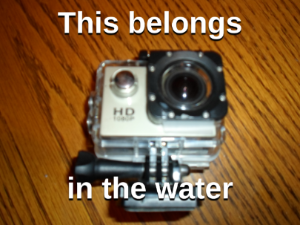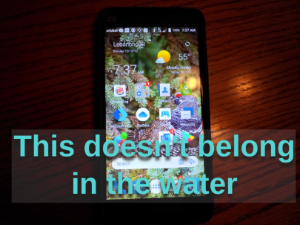You may see mobile device commercials that tell you how "waterproof" or "water resistant" a device is.
Remember, that these two definitions are not the same.
Water resistant means a spill such as dropping coffee on the screen or using you device in the rain.
Water proof implies that the device can be submerged in a liquid up to a certain depth (with an approved rating by the mfg).
You should always read the fine print went it comes to taking videos or pictures with your device under water. It is a good idea to use a waterproof container to put the device in that doesn't interfere with taking pictures. Camera stores and some websites may carry them.
The only real camera that does belong in the water for recording are Go Pro cameras (and other similar devices) that have a sealed plastic case designed for underwater use.
There are many similar Go Pro devices on Amazon for a lot less. The one in the photo sells for $40.00 and includes the accessories for using the camera in the water. Some Go Pro accessories can work on this particular model as well.
Keep in mind, that mobile devices may contain lead, mercury, and alkaline that can react to pool chemicals and salt water that can instantly turn your device, and the liquid that it is in, into a a very hazardous material since it was placed into liquids that are corrosive (salt water and chlorine).
Many mobile device do not have depth ratings listed because they have not been tested or approved for diving and swimming conditions. If the fine print doesn't have a depth rating, don't assume it can go in the water. If you are not sure, check with the manufacturer and don't assume the television commercial says it's OK to do so (as I have taught in class, there is the fine print displayed about it). A good rule to go by is this:
If it isn't used during Shark Week, it shouldn't be for scuba diving purposes.

(An inexpensive Go Pro knock off you can find on Amazon around $40.00. Most of the videos produced for this web server uses this camera)
Rice doesn’t get the water out of phone or tablet. That is myth that someone who isn’t an engineer came up with.
Use a duster can that is capable of evaporating moisture on contact.
This is one of the myths that television commercials have been debunked on this website.
